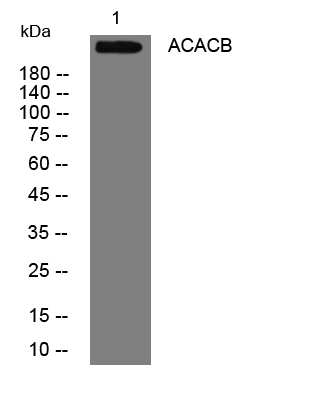- Home
- About
- Promotions
-
Products
-
Elisa Kits
- |
-
Primary antibodies
- |
-
Secondary antibodies
- |
-
Proteins
- |
-
IHC reagents
- |
-
WB reagents
- PonceauS Staining Solution
- PBST Washing Buffer, 10X
- 1.5M Tris-HCl Buffer, pH8.8
- 1M Tris-HCl Buffer, pH6.8
- 10% SDS Solution
- Prestained Protein Marker
- TBST Washing Buffer, 10X
- SDS PAGE Loading Buffer, 5X
- Stripping Buffered Solution
- Tris Buffer, pH7.4, 10X
- Total Protein Extraction Kit
- Running Buffer, 10X
- Transfer Buffer, 10X
- 30% Acr-Bis(29:1) Solution
- Tris电泳液速溶颗粒
- PBS(1X, premixed powder)
- TBS(1X, premixed powder)
- 快速封闭液
- 转膜液速溶颗粒
- Chemical reagents
- News
- Distributor
- Resources
- Contact
- Home
- >
- Info
- >
- ACACB rabbit pAb
- >
- Go Back
ACACB rabbit pAb
- Catalog No.:YT7481
- Applications:WB
- Reactivity:Human;Mouse
- Fields:
- >>Fatty acid biosynthesis;>>Pyruvate metabolism;>>Propanoate metabolism;>>Metabolic pathways;>>AMPK signaling pathway;>>Insulin signaling pathway;>>Adipocytokine signaling pathway;>>Glucagon signaling pathway;>>Insulin resistance;>>Alcoholic liver disease
- Gene Name:
- ACACB ACC2 ACCB
- Immunogen:
- Synthesized peptide derived from human ACACB
- Specificity:
- This antibody detects endogenous levels of ACACB at Human
- Formulation:
- Liquid in PBS containing 50% glycerol, 0.5% BSA and 0.02% sodium azide.
- Source:
- Polyclonal, Rabbit,IgG
- Purification:
- The antibody was affinity-purified from rabbit antiserum by affinity-chromatography using epitope-specific immunogen.
- Storage Stability:
- -15°C to -25°C/1 year(Do not lower than -25°C)
- Molecular Weight(Da):
- 270kD
- Background:
- Acetyl-CoA carboxylase (ACC) is a complex multifunctional enzyme system. ACC is a biotin-containing enzyme which catalyzes the carboxylation of acetyl-CoA to malonyl-CoA, the rate-limiting step in fatty acid synthesis. ACC-beta is thought to control fatty acid oxidation by means of the ability of malonyl-CoA to inhibit carnitine-palmitoyl-CoA transferase I, the rate-limiting step in fatty acid uptake and oxidation by mitochondria. ACC-beta may be involved in the regulation of fatty acid oxidation, rather than fatty acid biosynthesis. There is evidence for the presence of two ACC-beta isoforms. [provided by RefSeq, Jul 2008],
- Function:
- catalytic activity:ATP + acetyl-CoA + HCO(3)(-) = ADP + phosphate + malonyl-CoA.,catalytic activity:ATP + biotin-carboxyl-carrier protein + CO(2) = ADP + phosphate + carboxybiotin-carboxyl-carrier protein.,cofactor:Binds 2 manganese ions per subunit.,cofactor:Biotin.,enzyme regulation:Activated by citrate. Inhibited by malonyl-CoA.,function:ACC-beta may be involved in the provision of malonyl-CoA or in the regulation of fatty acid oxidation, rather than fatty acid biosynthesis. Carries out three functions: biotin carboxyl carrier protein, biotin carboxylase and carboxyltransferase.,pathway:Lipid metabolism; malonyl-CoA biosynthesis; malonyl-CoA from acetyl-CoA: step 1/1.,similarity:Contains 1 ATP-grasp domain.,similarity:Contains 1 biotin carboxylation domain.,similarity:Contains 1 biotinyl-binding domain.,similarity:Contains 1 carboxyltransferase domain.,subcellular location:May associa
- Subcellular Location:
- Mitochondrion .
- Expression:
- Widely expressed with highest levels in heart, skeletal muscle, liver, adipose tissue, mammary gland, adrenal gland and colon (PubMed:9099716). Isoform 3 is expressed in skeletal muscle, adipose tissue and liver (at protein level) (PubMed:19190759). Isoform 3 is detected at high levels in adipose tissue with lower levels in heart, liver, skeletal muscle and testis (PubMed:19190759).

- Western blot analysis of lysates from U2OS cells, primary antibody was diluted at 1:1000, 4°over night




